CNA344: Analysis of Clinical Reasoning Errors in Nursing Practice
VerifiedAdded on 2023/04/25
|8
|2232
|167
Report
AI Summary
This report analyzes a clinical encounter involving a 78-year-old female patient admitted to the hospital with shortness of breath and chest pain, ultimately diagnosed with a urinary tract infection (UTI). The report focuses on identifying and discussing clinical reasoning errors made during the assessment and diagnostic process. Specifically, it highlights premature closure, where the diagnosis of UTI was made without sufficient confirmatory testing, and over-confidence bias, where other potential contributing factors to the patient's symptoms were overlooked. The paper explores how these errors might have occurred, considering the patient's history of GORD and type 2 diabetes, and reflects on how the clinical reasoning process could have been improved to avoid these errors. The student reflects on new learning, emphasizing the importance of avoiding confidence bias, considering alternative diagnoses, and enhancing clinical reasoning skills to ensure safe and quality nursing practice. The report includes a discussion of relevant literature and references to support the analysis.

Running head: NURSING
Nursing
Name of the Student
Name of the University
Author Note
Nursing
Name of the Student
Name of the University
Author Note
Paraphrase This Document
Need a fresh take? Get an instant paraphrase of this document with our AI Paraphraser
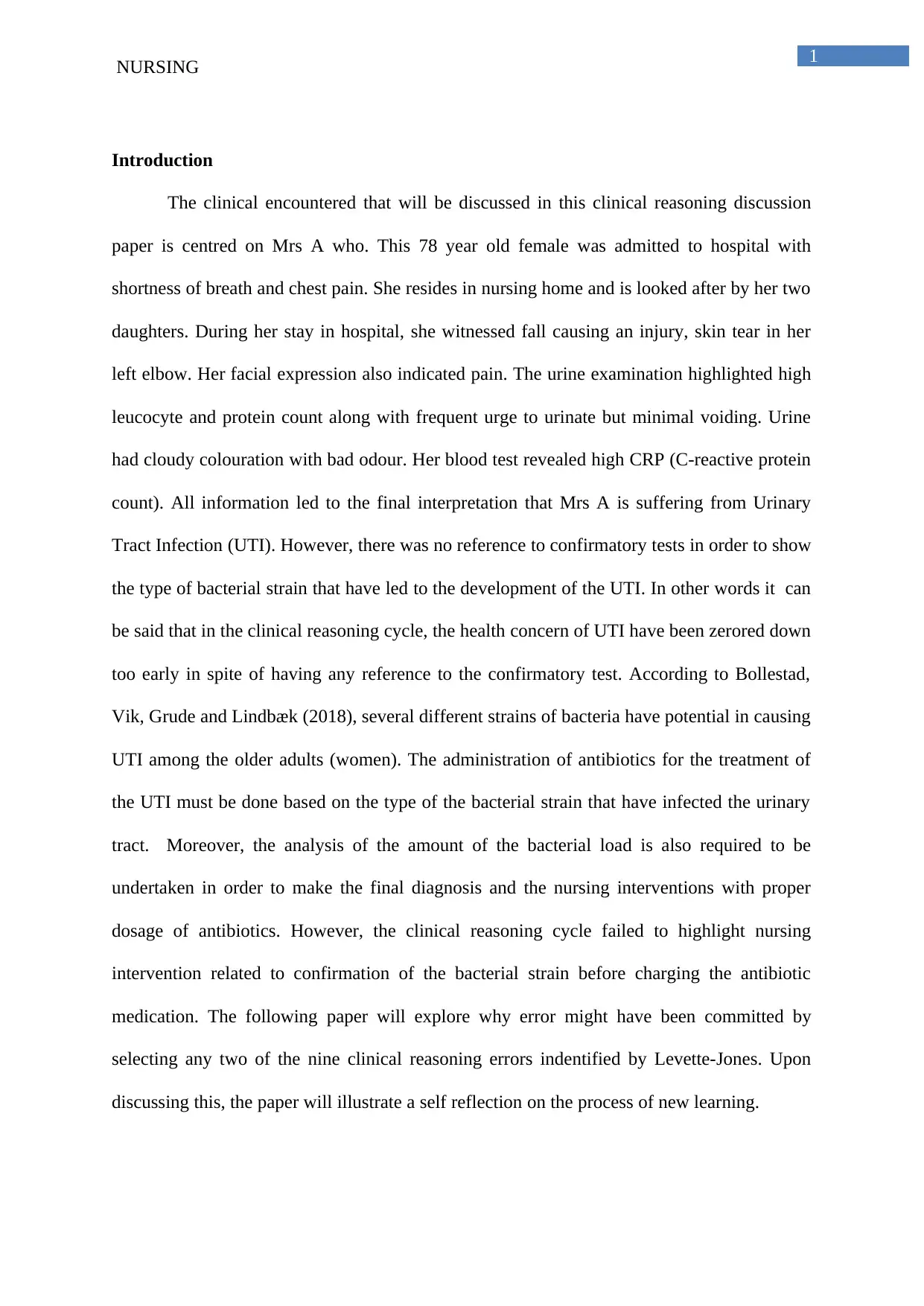
1
NURSING
Introduction
The clinical encountered that will be discussed in this clinical reasoning discussion
paper is centred on Mrs A who. This 78 year old female was admitted to hospital with
shortness of breath and chest pain. She resides in nursing home and is looked after by her two
daughters. During her stay in hospital, she witnessed fall causing an injury, skin tear in her
left elbow. Her facial expression also indicated pain. The urine examination highlighted high
leucocyte and protein count along with frequent urge to urinate but minimal voiding. Urine
had cloudy colouration with bad odour. Her blood test revealed high CRP (C-reactive protein
count). All information led to the final interpretation that Mrs A is suffering from Urinary
Tract Infection (UTI). However, there was no reference to confirmatory tests in order to show
the type of bacterial strain that have led to the development of the UTI. In other words it can
be said that in the clinical reasoning cycle, the health concern of UTI have been zerored down
too early in spite of having any reference to the confirmatory test. According to Bollestad,
Vik, Grude and Lindbæk (2018), several different strains of bacteria have potential in causing
UTI among the older adults (women). The administration of antibiotics for the treatment of
the UTI must be done based on the type of the bacterial strain that have infected the urinary
tract. Moreover, the analysis of the amount of the bacterial load is also required to be
undertaken in order to make the final diagnosis and the nursing interventions with proper
dosage of antibiotics. However, the clinical reasoning cycle failed to highlight nursing
intervention related to confirmation of the bacterial strain before charging the antibiotic
medication. The following paper will explore why error might have been committed by
selecting any two of the nine clinical reasoning errors indentified by Levette-Jones. Upon
discussing this, the paper will illustrate a self reflection on the process of new learning.
NURSING
Introduction
The clinical encountered that will be discussed in this clinical reasoning discussion
paper is centred on Mrs A who. This 78 year old female was admitted to hospital with
shortness of breath and chest pain. She resides in nursing home and is looked after by her two
daughters. During her stay in hospital, she witnessed fall causing an injury, skin tear in her
left elbow. Her facial expression also indicated pain. The urine examination highlighted high
leucocyte and protein count along with frequent urge to urinate but minimal voiding. Urine
had cloudy colouration with bad odour. Her blood test revealed high CRP (C-reactive protein
count). All information led to the final interpretation that Mrs A is suffering from Urinary
Tract Infection (UTI). However, there was no reference to confirmatory tests in order to show
the type of bacterial strain that have led to the development of the UTI. In other words it can
be said that in the clinical reasoning cycle, the health concern of UTI have been zerored down
too early in spite of having any reference to the confirmatory test. According to Bollestad,
Vik, Grude and Lindbæk (2018), several different strains of bacteria have potential in causing
UTI among the older adults (women). The administration of antibiotics for the treatment of
the UTI must be done based on the type of the bacterial strain that have infected the urinary
tract. Moreover, the analysis of the amount of the bacterial load is also required to be
undertaken in order to make the final diagnosis and the nursing interventions with proper
dosage of antibiotics. However, the clinical reasoning cycle failed to highlight nursing
intervention related to confirmation of the bacterial strain before charging the antibiotic
medication. The following paper will explore why error might have been committed by
selecting any two of the nine clinical reasoning errors indentified by Levette-Jones. Upon
discussing this, the paper will illustrate a self reflection on the process of new learning.
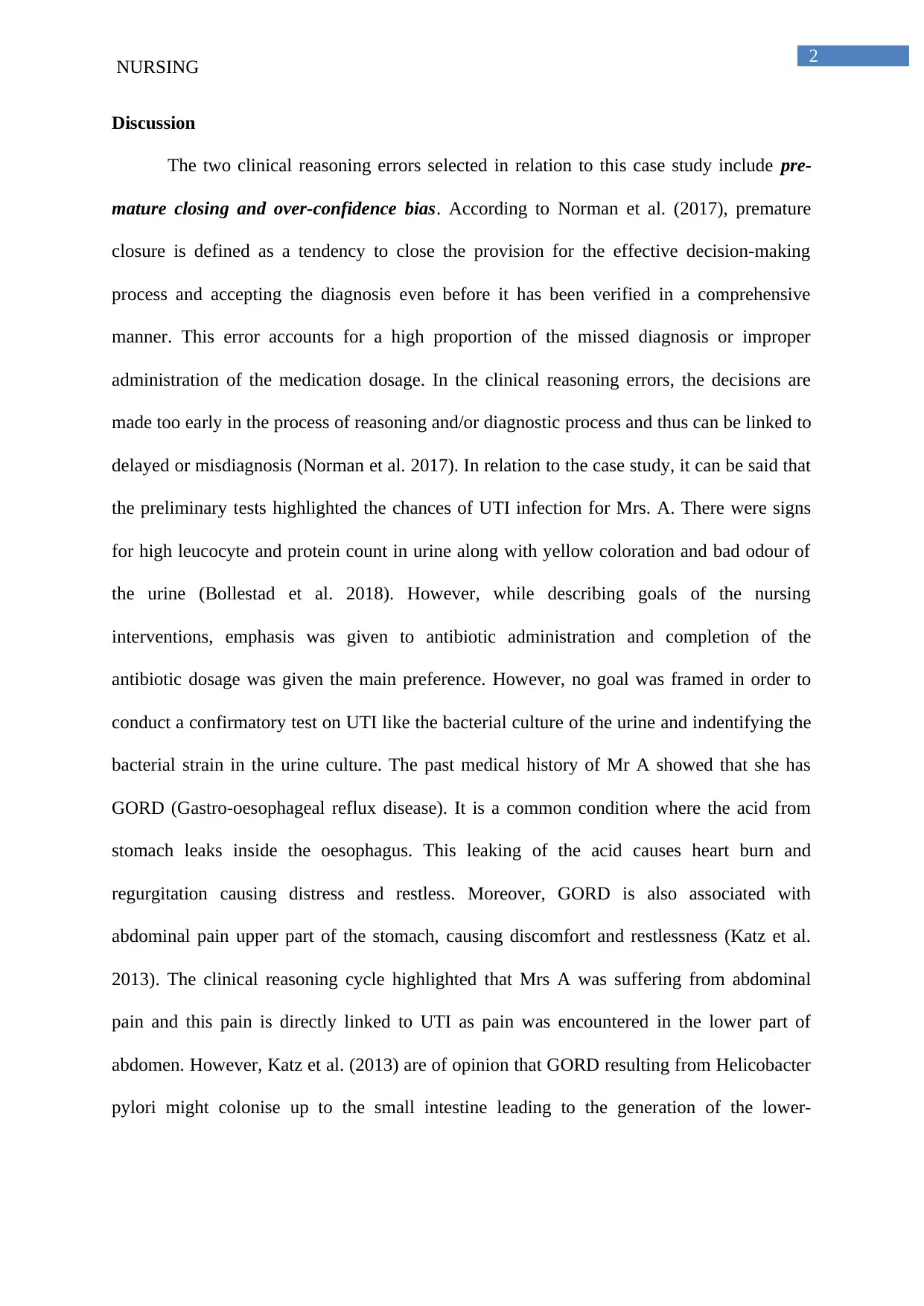
2
NURSING
Discussion
The two clinical reasoning errors selected in relation to this case study include pre-
mature closing and over-confidence bias. According to Norman et al. (2017), premature
closure is defined as a tendency to close the provision for the effective decision-making
process and accepting the diagnosis even before it has been verified in a comprehensive
manner. This error accounts for a high proportion of the missed diagnosis or improper
administration of the medication dosage. In the clinical reasoning errors, the decisions are
made too early in the process of reasoning and/or diagnostic process and thus can be linked to
delayed or misdiagnosis (Norman et al. 2017). In relation to the case study, it can be said that
the preliminary tests highlighted the chances of UTI infection for Mrs. A. There were signs
for high leucocyte and protein count in urine along with yellow coloration and bad odour of
the urine (Bollestad et al. 2018). However, while describing goals of the nursing
interventions, emphasis was given to antibiotic administration and completion of the
antibiotic dosage was given the main preference. However, no goal was framed in order to
conduct a confirmatory test on UTI like the bacterial culture of the urine and indentifying the
bacterial strain in the urine culture. The past medical history of Mr A showed that she has
GORD (Gastro-oesophageal reflux disease). It is a common condition where the acid from
stomach leaks inside the oesophagus. This leaking of the acid causes heart burn and
regurgitation causing distress and restless. Moreover, GORD is also associated with
abdominal pain upper part of the stomach, causing discomfort and restlessness (Katz et al.
2013). The clinical reasoning cycle highlighted that Mrs A was suffering from abdominal
pain and this pain is directly linked to UTI as pain was encountered in the lower part of
abdomen. However, Katz et al. (2013) are of opinion that GORD resulting from Helicobacter
pylori might colonise up to the small intestine leading to the generation of the lower-
NURSING
Discussion
The two clinical reasoning errors selected in relation to this case study include pre-
mature closing and over-confidence bias. According to Norman et al. (2017), premature
closure is defined as a tendency to close the provision for the effective decision-making
process and accepting the diagnosis even before it has been verified in a comprehensive
manner. This error accounts for a high proportion of the missed diagnosis or improper
administration of the medication dosage. In the clinical reasoning errors, the decisions are
made too early in the process of reasoning and/or diagnostic process and thus can be linked to
delayed or misdiagnosis (Norman et al. 2017). In relation to the case study, it can be said that
the preliminary tests highlighted the chances of UTI infection for Mrs. A. There were signs
for high leucocyte and protein count in urine along with yellow coloration and bad odour of
the urine (Bollestad et al. 2018). However, while describing goals of the nursing
interventions, emphasis was given to antibiotic administration and completion of the
antibiotic dosage was given the main preference. However, no goal was framed in order to
conduct a confirmatory test on UTI like the bacterial culture of the urine and indentifying the
bacterial strain in the urine culture. The past medical history of Mr A showed that she has
GORD (Gastro-oesophageal reflux disease). It is a common condition where the acid from
stomach leaks inside the oesophagus. This leaking of the acid causes heart burn and
regurgitation causing distress and restless. Moreover, GORD is also associated with
abdominal pain upper part of the stomach, causing discomfort and restlessness (Katz et al.
2013). The clinical reasoning cycle highlighted that Mrs A was suffering from abdominal
pain and this pain is directly linked to UTI as pain was encountered in the lower part of
abdomen. However, Katz et al. (2013) are of opinion that GORD resulting from Helicobacter
pylori might colonise up to the small intestine leading to the generation of the lower-
⊘ This is a preview!⊘
Do you want full access?
Subscribe today to unlock all pages.

Trusted by 1+ million students worldwide
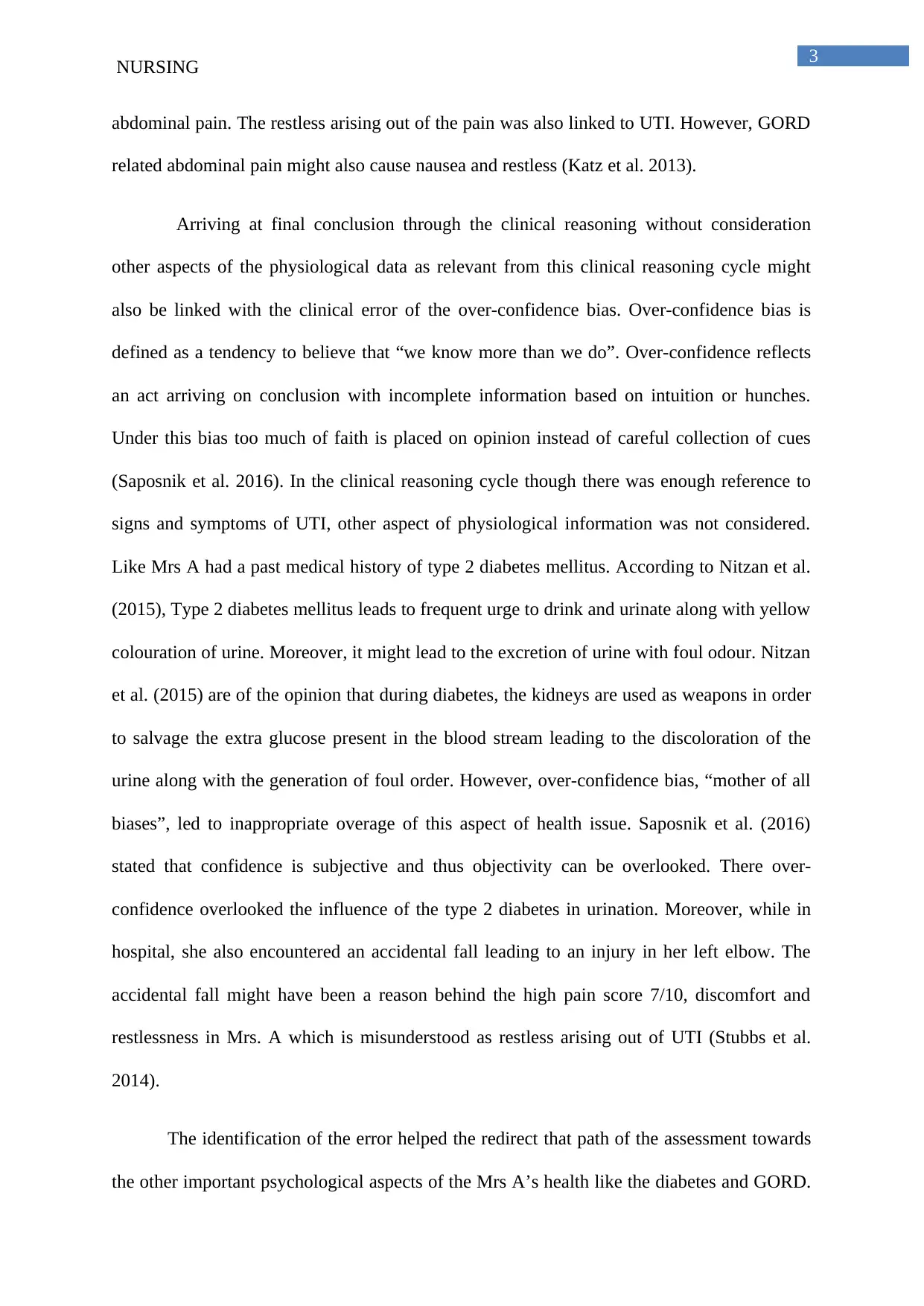
3
NURSING
abdominal pain. The restless arising out of the pain was also linked to UTI. However, GORD
related abdominal pain might also cause nausea and restless (Katz et al. 2013).
Arriving at final conclusion through the clinical reasoning without consideration
other aspects of the physiological data as relevant from this clinical reasoning cycle might
also be linked with the clinical error of the over-confidence bias. Over-confidence bias is
defined as a tendency to believe that “we know more than we do”. Over-confidence reflects
an act arriving on conclusion with incomplete information based on intuition or hunches.
Under this bias too much of faith is placed on opinion instead of careful collection of cues
(Saposnik et al. 2016). In the clinical reasoning cycle though there was enough reference to
signs and symptoms of UTI, other aspect of physiological information was not considered.
Like Mrs A had a past medical history of type 2 diabetes mellitus. According to Nitzan et al.
(2015), Type 2 diabetes mellitus leads to frequent urge to drink and urinate along with yellow
colouration of urine. Moreover, it might lead to the excretion of urine with foul odour. Nitzan
et al. (2015) are of the opinion that during diabetes, the kidneys are used as weapons in order
to salvage the extra glucose present in the blood stream leading to the discoloration of the
urine along with the generation of foul order. However, over-confidence bias, “mother of all
biases”, led to inappropriate overage of this aspect of health issue. Saposnik et al. (2016)
stated that confidence is subjective and thus objectivity can be overlooked. There over-
confidence overlooked the influence of the type 2 diabetes in urination. Moreover, while in
hospital, she also encountered an accidental fall leading to an injury in her left elbow. The
accidental fall might have been a reason behind the high pain score 7/10, discomfort and
restlessness in Mrs. A which is misunderstood as restless arising out of UTI (Stubbs et al.
2014).
The identification of the error helped the redirect that path of the assessment towards
the other important psychological aspects of the Mrs A’s health like the diabetes and GORD.
NURSING
abdominal pain. The restless arising out of the pain was also linked to UTI. However, GORD
related abdominal pain might also cause nausea and restless (Katz et al. 2013).
Arriving at final conclusion through the clinical reasoning without consideration
other aspects of the physiological data as relevant from this clinical reasoning cycle might
also be linked with the clinical error of the over-confidence bias. Over-confidence bias is
defined as a tendency to believe that “we know more than we do”. Over-confidence reflects
an act arriving on conclusion with incomplete information based on intuition or hunches.
Under this bias too much of faith is placed on opinion instead of careful collection of cues
(Saposnik et al. 2016). In the clinical reasoning cycle though there was enough reference to
signs and symptoms of UTI, other aspect of physiological information was not considered.
Like Mrs A had a past medical history of type 2 diabetes mellitus. According to Nitzan et al.
(2015), Type 2 diabetes mellitus leads to frequent urge to drink and urinate along with yellow
colouration of urine. Moreover, it might lead to the excretion of urine with foul odour. Nitzan
et al. (2015) are of the opinion that during diabetes, the kidneys are used as weapons in order
to salvage the extra glucose present in the blood stream leading to the discoloration of the
urine along with the generation of foul order. However, over-confidence bias, “mother of all
biases”, led to inappropriate overage of this aspect of health issue. Saposnik et al. (2016)
stated that confidence is subjective and thus objectivity can be overlooked. There over-
confidence overlooked the influence of the type 2 diabetes in urination. Moreover, while in
hospital, she also encountered an accidental fall leading to an injury in her left elbow. The
accidental fall might have been a reason behind the high pain score 7/10, discomfort and
restlessness in Mrs. A which is misunderstood as restless arising out of UTI (Stubbs et al.
2014).
The identification of the error helped the redirect that path of the assessment towards
the other important psychological aspects of the Mrs A’s health like the diabetes and GORD.
Paraphrase This Document
Need a fresh take? Get an instant paraphrase of this document with our AI Paraphraser
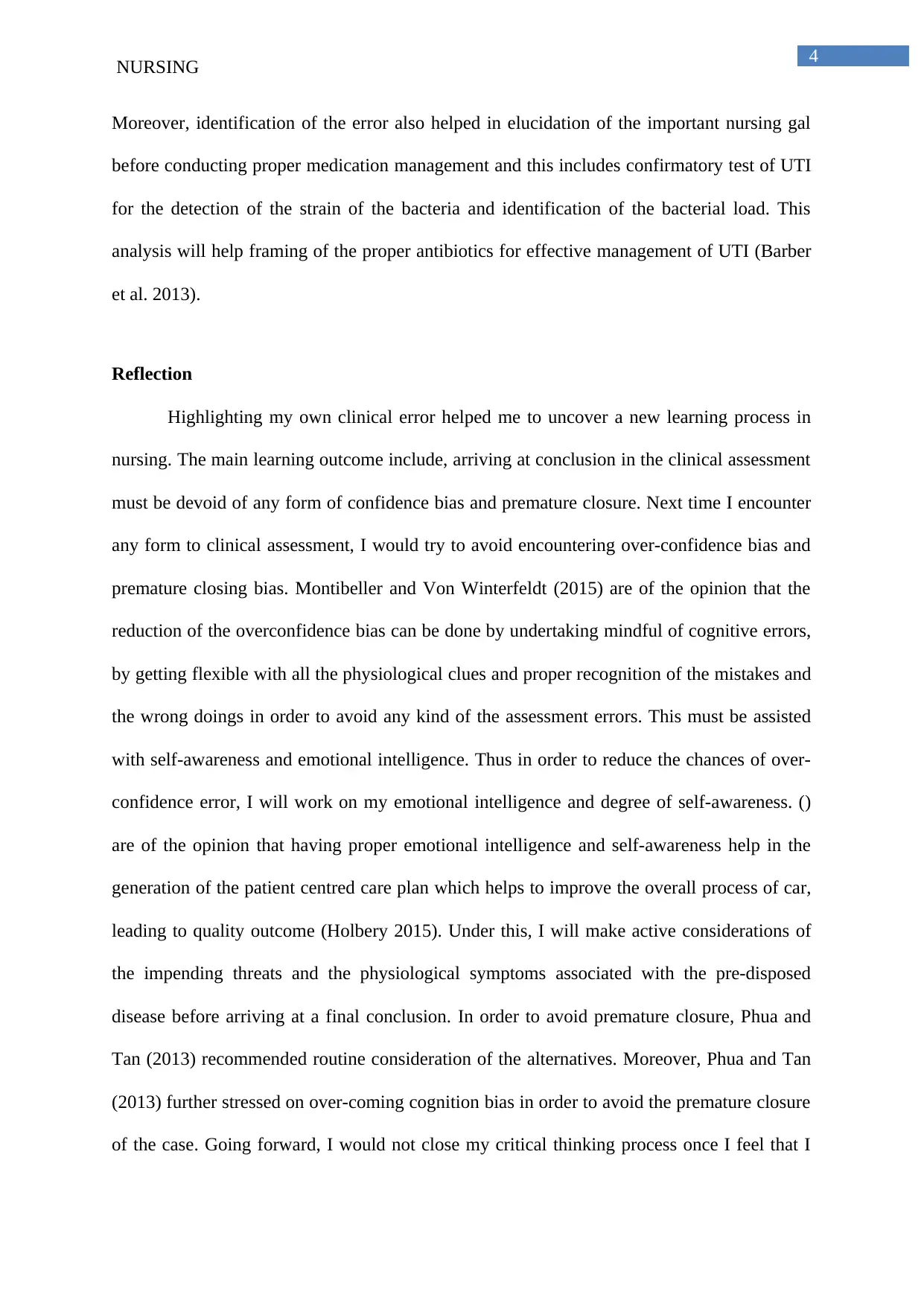
4
NURSING
Moreover, identification of the error also helped in elucidation of the important nursing gal
before conducting proper medication management and this includes confirmatory test of UTI
for the detection of the strain of the bacteria and identification of the bacterial load. This
analysis will help framing of the proper antibiotics for effective management of UTI (Barber
et al. 2013).
Reflection
Highlighting my own clinical error helped me to uncover a new learning process in
nursing. The main learning outcome include, arriving at conclusion in the clinical assessment
must be devoid of any form of confidence bias and premature closure. Next time I encounter
any form to clinical assessment, I would try to avoid encountering over-confidence bias and
premature closing bias. Montibeller and Von Winterfeldt (2015) are of the opinion that the
reduction of the overconfidence bias can be done by undertaking mindful of cognitive errors,
by getting flexible with all the physiological clues and proper recognition of the mistakes and
the wrong doings in order to avoid any kind of the assessment errors. This must be assisted
with self-awareness and emotional intelligence. Thus in order to reduce the chances of over-
confidence error, I will work on my emotional intelligence and degree of self-awareness. ()
are of the opinion that having proper emotional intelligence and self-awareness help in the
generation of the patient centred care plan which helps to improve the overall process of car,
leading to quality outcome (Holbery 2015). Under this, I will make active considerations of
the impending threats and the physiological symptoms associated with the pre-disposed
disease before arriving at a final conclusion. In order to avoid premature closure, Phua and
Tan (2013) recommended routine consideration of the alternatives. Moreover, Phua and Tan
(2013) further stressed on over-coming cognition bias in order to avoid the premature closure
of the case. Going forward, I would not close my critical thinking process once I feel that I
NURSING
Moreover, identification of the error also helped in elucidation of the important nursing gal
before conducting proper medication management and this includes confirmatory test of UTI
for the detection of the strain of the bacteria and identification of the bacterial load. This
analysis will help framing of the proper antibiotics for effective management of UTI (Barber
et al. 2013).
Reflection
Highlighting my own clinical error helped me to uncover a new learning process in
nursing. The main learning outcome include, arriving at conclusion in the clinical assessment
must be devoid of any form of confidence bias and premature closure. Next time I encounter
any form to clinical assessment, I would try to avoid encountering over-confidence bias and
premature closing bias. Montibeller and Von Winterfeldt (2015) are of the opinion that the
reduction of the overconfidence bias can be done by undertaking mindful of cognitive errors,
by getting flexible with all the physiological clues and proper recognition of the mistakes and
the wrong doings in order to avoid any kind of the assessment errors. This must be assisted
with self-awareness and emotional intelligence. Thus in order to reduce the chances of over-
confidence error, I will work on my emotional intelligence and degree of self-awareness. ()
are of the opinion that having proper emotional intelligence and self-awareness help in the
generation of the patient centred care plan which helps to improve the overall process of car,
leading to quality outcome (Holbery 2015). Under this, I will make active considerations of
the impending threats and the physiological symptoms associated with the pre-disposed
disease before arriving at a final conclusion. In order to avoid premature closure, Phua and
Tan (2013) recommended routine consideration of the alternatives. Moreover, Phua and Tan
(2013) further stressed on over-coming cognition bias in order to avoid the premature closure
of the case. Going forward, I would not close my critical thinking process once I feel that I
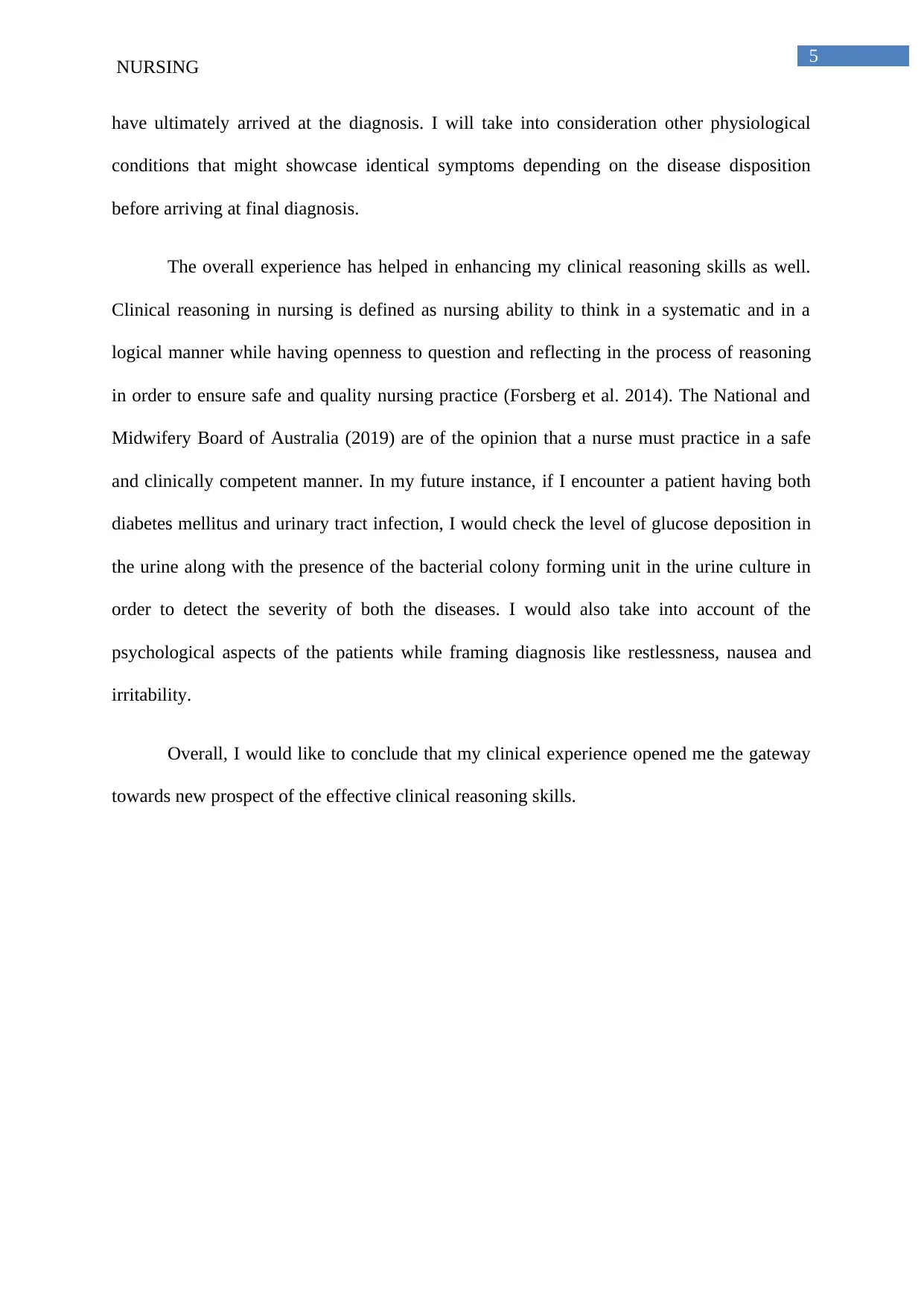
5
NURSING
have ultimately arrived at the diagnosis. I will take into consideration other physiological
conditions that might showcase identical symptoms depending on the disease disposition
before arriving at final diagnosis.
The overall experience has helped in enhancing my clinical reasoning skills as well.
Clinical reasoning in nursing is defined as nursing ability to think in a systematic and in a
logical manner while having openness to question and reflecting in the process of reasoning
in order to ensure safe and quality nursing practice (Forsberg et al. 2014). The National and
Midwifery Board of Australia (2019) are of the opinion that a nurse must practice in a safe
and clinically competent manner. In my future instance, if I encounter a patient having both
diabetes mellitus and urinary tract infection, I would check the level of glucose deposition in
the urine along with the presence of the bacterial colony forming unit in the urine culture in
order to detect the severity of both the diseases. I would also take into account of the
psychological aspects of the patients while framing diagnosis like restlessness, nausea and
irritability.
Overall, I would like to conclude that my clinical experience opened me the gateway
towards new prospect of the effective clinical reasoning skills.
NURSING
have ultimately arrived at the diagnosis. I will take into consideration other physiological
conditions that might showcase identical symptoms depending on the disease disposition
before arriving at final diagnosis.
The overall experience has helped in enhancing my clinical reasoning skills as well.
Clinical reasoning in nursing is defined as nursing ability to think in a systematic and in a
logical manner while having openness to question and reflecting in the process of reasoning
in order to ensure safe and quality nursing practice (Forsberg et al. 2014). The National and
Midwifery Board of Australia (2019) are of the opinion that a nurse must practice in a safe
and clinically competent manner. In my future instance, if I encounter a patient having both
diabetes mellitus and urinary tract infection, I would check the level of glucose deposition in
the urine along with the presence of the bacterial colony forming unit in the urine culture in
order to detect the severity of both the diseases. I would also take into account of the
psychological aspects of the patients while framing diagnosis like restlessness, nausea and
irritability.
Overall, I would like to conclude that my clinical experience opened me the gateway
towards new prospect of the effective clinical reasoning skills.
⊘ This is a preview!⊘
Do you want full access?
Subscribe today to unlock all pages.

Trusted by 1+ million students worldwide

6
NURSING
References
Barber, A.E., Norton, J.P., Spivak, A.M. and Mulvey, M.A., 2013. Urinary tract infections:
current and emerging management strategies. Clinical infectious diseases, 57(5), pp.719-724.
Bollestad, M., Vik, I., Grude, N. and Lindbæk, M., 2018. Predictors of symptom duration and
bacteriuria in uncomplicated urinary tract infection. Scandinavian journal of primary health
care, 36(4), pp.446-454.
Forsberg, E., Ziegert, K., Hult, H. and Fors, U., 2014. Clinical reasoning in nursing, a think-
aloud study using virtual patients–A base for an innovative assessment. Nurse Education
Today, 34(4), pp.538-542.
Holbery, N., 2015. Emotional intelligence–essential for trauma nursing. International
emergency nursing, 23(1), pp.13-16.
Katz, P.O., Gerson, L.B. and Vela, M.F., 2013. Guidelines for the diagnosis and management
of gastroesophageal reflux disease. The American journal of gastroenterology, 108(3), p.308.
Montibeller, G. and Von Winterfeldt, D., 2015. Cognitive and motivational biases in decision
and risk analysis. Risk Analysis, 35(7), pp.1230-1251.
National and Midwifery Board of Australia. 2019. Code of Professional Conduct. Access
date: 29th Jan 2019; Retrieved from: https://www.nursingmidwiferyboard.gov.au/codes-
guidelines-statements/professional-standards.aspx
Nitzan, O., Elias, M., Chazan, B. and Saliba, W., 2015. Urinary tract infections in patients
with type 2 diabetes mellitus: review of prevalence, diagnosis, and management. Diabetes,
metabolic syndrome and obesity: targets and therapy, 8, p.129.
NURSING
References
Barber, A.E., Norton, J.P., Spivak, A.M. and Mulvey, M.A., 2013. Urinary tract infections:
current and emerging management strategies. Clinical infectious diseases, 57(5), pp.719-724.
Bollestad, M., Vik, I., Grude, N. and Lindbæk, M., 2018. Predictors of symptom duration and
bacteriuria in uncomplicated urinary tract infection. Scandinavian journal of primary health
care, 36(4), pp.446-454.
Forsberg, E., Ziegert, K., Hult, H. and Fors, U., 2014. Clinical reasoning in nursing, a think-
aloud study using virtual patients–A base for an innovative assessment. Nurse Education
Today, 34(4), pp.538-542.
Holbery, N., 2015. Emotional intelligence–essential for trauma nursing. International
emergency nursing, 23(1), pp.13-16.
Katz, P.O., Gerson, L.B. and Vela, M.F., 2013. Guidelines for the diagnosis and management
of gastroesophageal reflux disease. The American journal of gastroenterology, 108(3), p.308.
Montibeller, G. and Von Winterfeldt, D., 2015. Cognitive and motivational biases in decision
and risk analysis. Risk Analysis, 35(7), pp.1230-1251.
National and Midwifery Board of Australia. 2019. Code of Professional Conduct. Access
date: 29th Jan 2019; Retrieved from: https://www.nursingmidwiferyboard.gov.au/codes-
guidelines-statements/professional-standards.aspx
Nitzan, O., Elias, M., Chazan, B. and Saliba, W., 2015. Urinary tract infections in patients
with type 2 diabetes mellitus: review of prevalence, diagnosis, and management. Diabetes,
metabolic syndrome and obesity: targets and therapy, 8, p.129.
Paraphrase This Document
Need a fresh take? Get an instant paraphrase of this document with our AI Paraphraser
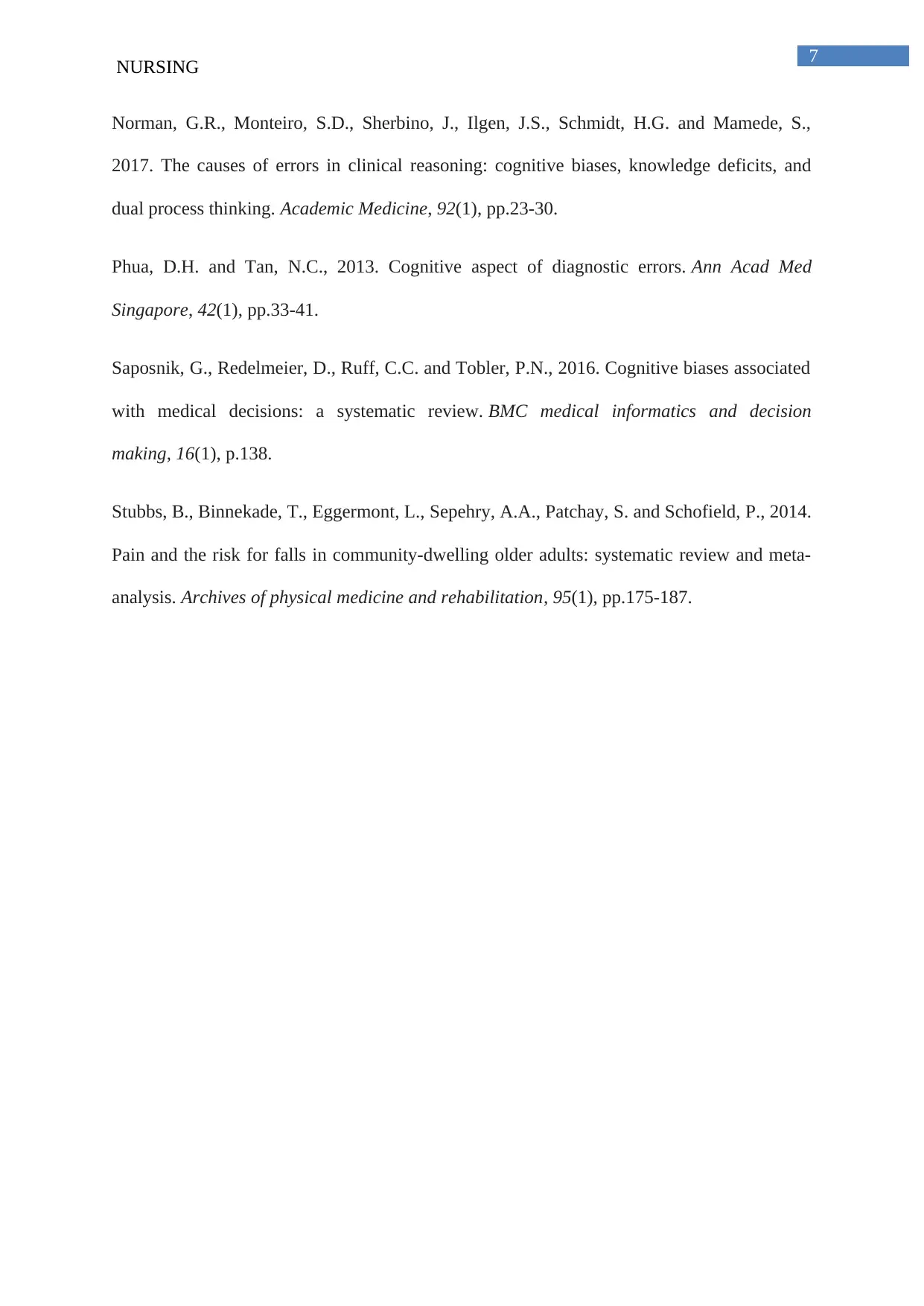
7
NURSING
Norman, G.R., Monteiro, S.D., Sherbino, J., Ilgen, J.S., Schmidt, H.G. and Mamede, S.,
2017. The causes of errors in clinical reasoning: cognitive biases, knowledge deficits, and
dual process thinking. Academic Medicine, 92(1), pp.23-30.
Phua, D.H. and Tan, N.C., 2013. Cognitive aspect of diagnostic errors. Ann Acad Med
Singapore, 42(1), pp.33-41.
Saposnik, G., Redelmeier, D., Ruff, C.C. and Tobler, P.N., 2016. Cognitive biases associated
with medical decisions: a systematic review. BMC medical informatics and decision
making, 16(1), p.138.
Stubbs, B., Binnekade, T., Eggermont, L., Sepehry, A.A., Patchay, S. and Schofield, P., 2014.
Pain and the risk for falls in community-dwelling older adults: systematic review and meta-
analysis. Archives of physical medicine and rehabilitation, 95(1), pp.175-187.
NURSING
Norman, G.R., Monteiro, S.D., Sherbino, J., Ilgen, J.S., Schmidt, H.G. and Mamede, S.,
2017. The causes of errors in clinical reasoning: cognitive biases, knowledge deficits, and
dual process thinking. Academic Medicine, 92(1), pp.23-30.
Phua, D.H. and Tan, N.C., 2013. Cognitive aspect of diagnostic errors. Ann Acad Med
Singapore, 42(1), pp.33-41.
Saposnik, G., Redelmeier, D., Ruff, C.C. and Tobler, P.N., 2016. Cognitive biases associated
with medical decisions: a systematic review. BMC medical informatics and decision
making, 16(1), p.138.
Stubbs, B., Binnekade, T., Eggermont, L., Sepehry, A.A., Patchay, S. and Schofield, P., 2014.
Pain and the risk for falls in community-dwelling older adults: systematic review and meta-
analysis. Archives of physical medicine and rehabilitation, 95(1), pp.175-187.
1 out of 8
Related Documents
Your All-in-One AI-Powered Toolkit for Academic Success.
+13062052269
info@desklib.com
Available 24*7 on WhatsApp / Email
![[object Object]](/_next/static/media/star-bottom.7253800d.svg)
Unlock your academic potential
Copyright © 2020–2025 A2Z Services. All Rights Reserved. Developed and managed by ZUCOL.





